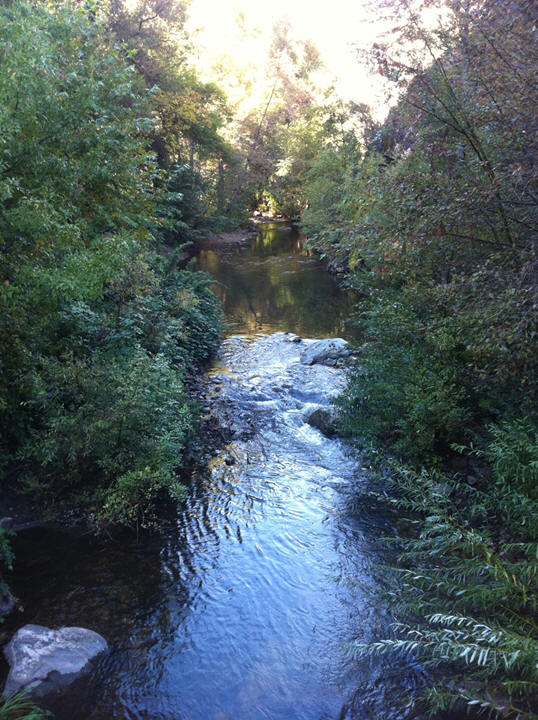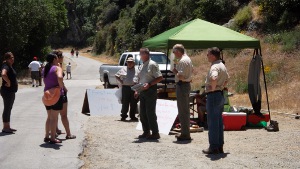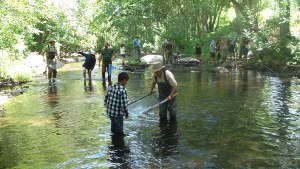|
 Many Southern California Fly Fishermen who have been in the area for any length of time have a favorite “local spot”. When Mammoth or the Kern isn’t in the cards but you just HAVE to get out and fish, where do you go? Piru Creek? Deep Creek? SAR? Many Southern California Fly Fishermen who have been in the area for any length of time have a favorite “local spot”. When Mammoth or the Kern isn’t in the cards but you just HAVE to get out and fish, where do you go? Piru Creek? Deep Creek? SAR?
For a good number of us a long time favorite has been the West Fork of the San Gabriel River. Many of us have honed our skills on the West Fork and have fished it for decades. The West Fork is close to Los Angeles and Orange County, offers easy access, and allows us to get out and drown some flies less than an hour from home.
For those unfamiliar with the West Fork, it is one of the few catch & release “Wild Trout’ fisheries in Southern California, with a six mile stretch of Wild Trout area between Highway 39 and the Cogswell dam. A well maintained, gated service road runs the length of this tail water between the highway and the dam, with an elevation gain of just 400’ over its entire length. The C&R area begins 1.5 miles upstream of the highway and is a very easy walk. The most popular form of transportation by “regulars” is a bicycle, allowing them to cover a lot of ground in a little time.
San Gabriel Canyon’s ease of access to millions of Southern California residents is a good news bad news story. Good for those of us who know the area and know where to get away from the crowds, but bad if you’re a fish. As the three forks of the San Gabriel are all easily accessible from paved roads with ample parking, they are seriously over stressed this time of year. The human impact during the summer months can be devastating to these fisheries with tens of thousands of visitors on a hot summer weekend, all trying to cool off and play in the rivers. Hundreds of pools choked by recreational dams and polluted with litter are no place to be if you’re a Trout!
Conditions in “the Canyon” have been growing steadily worse over the past decade. Visitor numbers are sky rocketing to all time highs, while budgets and Forest Service staffing are at all time lows. After observing this trend, the West Fork San Gabriel River Conservancy was formed by a local group of Fly Fishermen to focus on the restoration and preservation of this Wild Trout fishery.
With guidance from Angeles National Forest staff, the “WFC” was formed as a California non-profit organization, and our founding members underwent their first Forest Service training. A combination of training and time in the field allows our volunteers to carry Forest Service radios and wear a Forest Service uniform. A “uniformed presence” in the area helps greatly to reduce the number of fishing violations upstream as well as reducing the amount of graffiti and litter downstream.
The Conservancy has taken a proactive approach to changing visitor behaviors that have a negative impact on the West Fork. Educating the visitors is the key. Many have no concept of “Leave No Trace”, or how to preserve the area for future generations. Rather than simply cleaning up after visitors when they leave, we are actively talking to them during their visits, providing trash bags when needed, and encouraging them to keep the area clean so that it’s “healthy” for their next visit. In addition to educating visitors face to face, WFC is producing short and direct bi-lingual graphic signs to address the most repetitive problems that we have experienced.
During the height of fishing season, WFC sets up an information canopy at the start of the C&R area, displaying stream samples and tying flies to replicate them. Top producing flies are made available to fly fishermen in need as well as fly & bubble rigs to introduce a few lucky spin fishermen to fly fishing. We’ve seen a number of spin fishermen have their first “fly fishing” success with one of these rigs, only to return the next week with a brand new fly rod & reel. “Welcome to the obsession!” This position on the river also allows us to contact every fisherman entering the area to make sure that they are fully aware of the special regulations, help them to pinch their barbs, and answer any questions that they may have.
The “off season” between October and May allows us to focus our attention on area improvements, facility maintenance, and more education. Our “Next Gen” Fly Academies typically take place in the fall and spring months. The Next Gen Academies are open to kids between the ages of 10-16 and are held at the West Fork’s Glenn Campground, roughly one mile below Cogswell Dam.
 Next Gen programs are a two day learning experience and campout covering how to read the stream, what the fish are eating, how to pick and rig the right fly, then how to present it and catch a fish. The more advanced “Entomology Academy” takes returning students more deeply in to the life cycles in the river and tying the flies needed to match the hatch. The final program is the “Competition Academy” where students not only compete in a tournament utilizing FFF tournament rules, but also compete in a number of conservation competitions as well. Next Gen programs are a two day learning experience and campout covering how to read the stream, what the fish are eating, how to pick and rig the right fly, then how to present it and catch a fish. The more advanced “Entomology Academy” takes returning students more deeply in to the life cycles in the river and tying the flies needed to match the hatch. The final program is the “Competition Academy” where students not only compete in a tournament utilizing FFF tournament rules, but also compete in a number of conservation competitions as well.
WCF is always looking for like minded volunteers that want to get out and make a difference. Our volunteers work at their own comfort level and there are tasks available for all ability levels. Our typical patrols are six hours in duration, however we would welcome you to come out and join us with any time that you have available, whether it’s for a couple of hours, or an entire patrol. Our patrol dates and more patrol information are located on our website www.WestForkSGRC.org
|